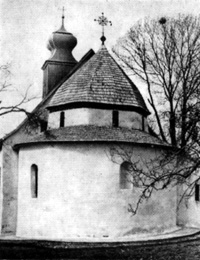History of a unique architectural monument

This church is also called the Horiany Rotunda, for it is situated in Uzhhorod’s Horiany neighborhood, Transcarpathia. The structure is round and derives its name from the Italian rotonda which has, in its turn, been derived from the Latin rotundus. The church’s strong walls were made of brick resembling the baked slab type used in Kyivan Rus. Its simplicity always arouses solemn and elevated feelings. Later, the nave, an elongated rectangular space, was attached to the church. But in general, St. Ann’s retains the features of ancient tradition.
Simple rotundas were of frequent occurrence in fourth century Rome. They were located near basilicas and played the role of so- called mortiriae, i.e., monuments in honor of one disciple (apostle) or another. Their architectural form was borrowed from the more ancient forms of Roman mausoleums brought from the Middle East. The mortiriae were gradually transformed into places of baptism, bastilliae, and still later, in the early medieval times, into the castle chapels of feudal lords.
According to symbols of the Christian cult, a circular structure means the whole world, the cosmos, under the auspices of God the Creator. Therefore, the symbolic meaning of the rotunda was gradually transforming form commemorating a holy martyr to glorifying God, the church, and the feudal lord who represented God on earth. This form of religious structures also extended later to the Balkans from where it came to Central Europe, Great Moravia, Bohemia, Hungary, and Poland. That the Horiany rotunda was built with participation of the masters of Byzantine origin is proved by its having been made of brick rather than wood, the traditional building material for the churches of those times. The rotunda stands on a high hill with the remnants of a medieval town a later fortifications of a medieval castle, which confirms the hypothesis that the Horiany Rotunda was the private temple of a feudal lord. Experts believe the time of its construction dates to the eleventh century. It is then that the wall were painted over, but later in the fourteenth century the original painting was overlapped with Gothic pictures in the traditions of the Italian early Renaissance school of Giotto (1266-1337).
The masters who painted the rotunda might have come to Uzhhorod together with Nicholas Druget, the owner of Horiany, who returned from Naples in 1354 after a three-year stay. Incidentally, wandering groups of Italian artists redecorated many churches in neighboring Slovakia, for their pictures resemble very much those in the Horiany Rotunda. ...The rotunda’s history began in the early fourteenth century, when Hungarian King Charles Robert of Anjou simply granted the huge Uzhhorod fief to the Italian clan of Counts Druget who had a castle in Horiany and then also began to order highly artistic frescoes. Thus Italy did not take Uzhhorod unaware. Everything was done according to plan.
It is not known who exactly painted the frescoes The Way to Golgotha, Christ Before Pilate, The Crucifixion, Annunciation, Flight to Egypt, and others. Unfortunately, the paintings have felt the ravages of time. It was repeatedly bleached and then restored in panic. Only in Soviet times were the frescoes finally cleaned and restored. Still, during perestroika: the “connoisseurs” of more modern painting decided to remove the old pictures and invite young artists to make new frescoes. Luckily, public opinion did not allow this. The old frescoes, although bleached, were still rescued.
According to the canons of the Giotto school, the events portrayed go in succession. They are very closely connected with each other, like in a film. Owing to this, St. Ann’s Church looks like as a small but well-stocked gallery which allows one to glimpse the far from the Middle Ages and then compare them with our own no less complicated day.






